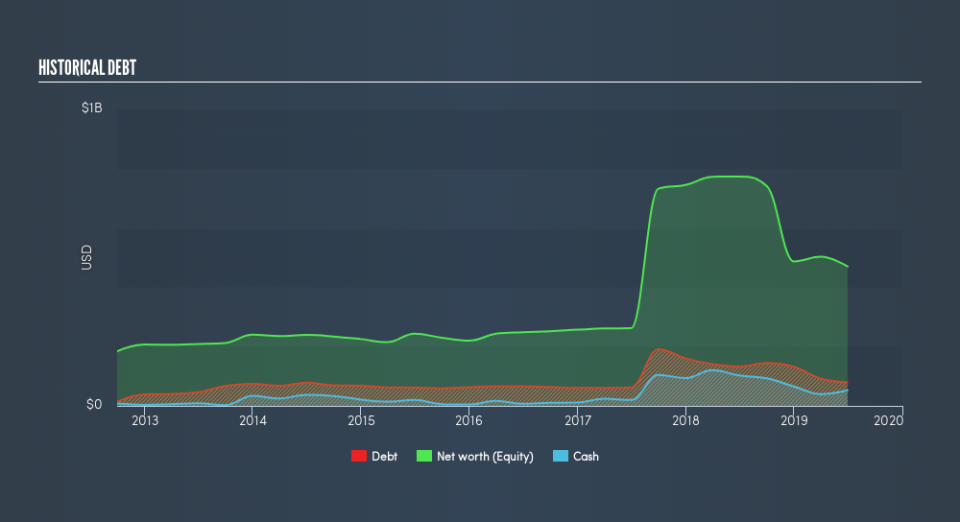Is Trevali Mining (TSE:TV) Using Debt In A Risky Way?

Some say volatility, rather than debt, is the best way to think about risk as an investor, but Warren Buffett famously said that 'Volatility is far from synonymous with risk.' So it seems the smart money knows that debt - which is usually involved in bankruptcies - is a very important factor, when you assess how risky a company is. We can see that Trevali Mining Corporation (TSE:TV) does use debt in its business. But should shareholders be worried about its use of debt?
When Is Debt Dangerous?
Debt assists a business until the business has trouble paying it off, either with new capital or with free cash flow. Ultimately, if the company can't fulfill its legal obligations to repay debt, shareholders could walk away with nothing. However, a more frequent (but still costly) occurrence is where a company must issue shares at bargain-basement prices, permanently diluting shareholders, just to shore up its balance sheet. Of course, the upside of debt is that it often represents cheap capital, especially when it replaces dilution in a company with the ability to reinvest at high rates of return. The first thing to do when considering how much debt a business uses is to look at its cash and debt together.
See our latest analysis for Trevali Mining
How Much Debt Does Trevali Mining Carry?
As you can see below, Trevali Mining had US$79.6m of debt at June 2019, down from US$143.2m a year prior. However, because it has a cash reserve of US$52.8m, its net debt is less, at about US$26.8m.
How Healthy Is Trevali Mining's Balance Sheet?
Zooming in on the latest balance sheet data, we can see that Trevali Mining had liabilities of US$71.5m due within 12 months and liabilities of US$229.7m due beyond that. Offsetting these obligations, it had cash of US$52.8m as well as receivables valued at US$45.0m due within 12 months. So its liabilities outweigh the sum of its cash and (near-term) receivables by US$203.4m.
The deficiency here weighs heavily on the US$113.1m company itself, as if a child were struggling under the weight of an enormous back-pack full of books, his sports gear, and a trumpet. So we'd watch its balance sheet closely, without a doubt At the end of the day, Trevali Mining would probably need a major re-capitalization if its creditors were to demand repayment. There's no doubt that we learn most about debt from the balance sheet. But it is future earnings, more than anything, that will determine Trevali Mining's ability to maintain a healthy balance sheet going forward. So if you want to see what the professionals think, you might find this free report on analyst profit forecasts to be interesting.
Over 12 months, Trevali Mining saw its revenue drop to US$349m, which is a fall of 30%. That makes us nervous, to say the least.
Caveat Emptor
Not only did Trevali Mining's revenue slip over the last twelve months, but it also produced negative earnings before interest and tax (EBIT). Its EBIT loss was a whopping US$54m. When we look at that alongside the significant liabilities, we're not particularly confident about the company. We'd want to see some strong near-term improvements before getting too interested in the stock. For example, we would not want to see a repeat of last year's loss of-US$284.2m. In the meantime, we consider the stock to be risky. For riskier companies like Trevali Mining I always like to keep an eye on whether insiders are buying or selling. So click here if you want to find out for yourself.
Of course, if you're the type of investor who prefers buying stocks without the burden of debt, then don't hesitate to discover our exclusive list of net cash growth stocks, today.
We aim to bring you long-term focused research analysis driven by fundamental data. Note that our analysis may not factor in the latest price-sensitive company announcements or qualitative material.
If you spot an error that warrants correction, please contact the editor at editorial-team@simplywallst.com. This article by Simply Wall St is general in nature. It does not constitute a recommendation to buy or sell any stock, and does not take account of your objectives, or your financial situation. Simply Wall St has no position in the stocks mentioned. Thank you for reading.

 Yahoo Finance
Yahoo Finance 
